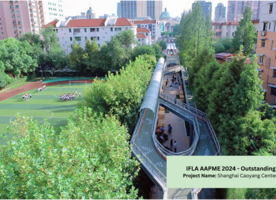News
Farmscape: The Design of Productive Landscapes
Posted 21 07 2020
in News
Phoebe Lickwar, ASLA, and Roxi Thoren, ASLA, have just published an excellent new book, Farmscape: The Design of Productive Landscapes (Routledge, 2020), which should consolidate many stirrings of the past decade in landscape architecture to reclaim a serious purchase on food production after generations of the two realms’ drifting apart. The book speaks into the gaps among where food is made, where it’s needed, and where it’s eaten. The examples pull from history through to recent practice, with the ornamented farm of early 1700s Britain; Frederick Law Olmsted’s Moraine Farm; the urban gardens of Leberecht Migge and Leopold Fischer in Dessau, Germany; and works by Martha Schwartz Partners, Mithun, and Nelson Byrd Woltz.
Just as the book came out, the pandemic began, quickly raising questions about food supplies. There were numerous reports of stalled and wasted produce, dairy, and eggs. Meatpacking plants were struck by outbreaks of COVID-19. LAM asked Lickwar and Thoren to trade notes by e-mail for a week in April about their reactions to the kinds of disruptions emerging, and how more intentional, landscape-driven approaches to food production might avert other disruptions down the line.
Farmscape: The Design of Productive Landscapes situates agriculture as a design practice, using a wide range of international case studies and analytical essays to propose lessons for contemporary landscape architects who are interested in integrating agriculture into their designs. Agricultural processes, technologies, and cycles have long shaped landscape architectural projects, from the ornamented farm of the eighteenth century, to contemporary projects that integrate agriculture and ecological restoration. The book describes the history of agriculture within landscape architecture and reveals the diversity of current design practices that use the rhythms and forms of agriculture to create productive farms that are also sites of beauty, community, ecological conservation, remediation, and pleasure. Highly illustrated in full colour, this book provides essential context, resources, and best practice examples of rural and periurban designed sites for professionals and students alike
10 Dec
Proposed replacement of the RMA: Planning Bill and Natural Environment Bill

A message from the Environmental Legislation Working Group
On Tuesday this week, the Government released proposed bills to replace the Resource Management Act 1991. Reform of our planning …
03 Dec
Newly Registered Landscape Architects 2025

Celebrating professional achievement across Aotearoa The 2025 Registration process is now nearing completion, and we are delighted to acknowledge the …
02 Dec
2025 IFLA APR Newsletter

November Edition
2025 IFLA APR Newsletter: November Edition November brings exciting updates from across the region. We’re welcoming the new IFLA APR …
Events calendar
Full 2025 calendar